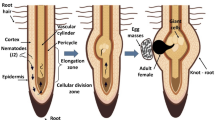Abstract
Incorporation into soil of dry mycelium ofPenicillium chrysogenum, a waste product of the pharmacological industry, enhanced plant growth and reduced root galling caused by the root-knot nematodeMeloidogyne javanica in cucumber and tomato plants. Incorporation into sandy loam soil in pots of dry mycelium at a concentration of 0.25% (w/w) resulted in complete protection of cucumber plants from the nematode. The number of juveniles recovered from soils containing dry mycelium was greatly reduced even at a concentration of 0.1% (w/w). In microplot studies conducted at two sites in two seasons, with three or four doses, dry mycelium caused a dose-dependent reduction in root galling index (GI) and promotion of plant growth of cucumber and tomato plants. Inin vitro studies, the water extract of dry mycelium immobilized nematode juveniles and reduced the egg hatching rate, but these effects were partly reversible after a rinse in water. Soil-drenching of cucumber and tomato seedlings with water extract of dry mycelium did not reduce GI or number of root-invading juveniles. The results show that dry mycelium promotes plant growth and protects plants against nematode infection. Protection, however, does not operatevia induced resistance.
Similar content being viewed by others
References
Barker, K.R. (1985) Nematode extraction and bioassays.in: Barker, K.R., Carter, C.C. and Sasser, J.N. [Eds.] An Advanced Treatise onMeloidogyne, Vol. 2, Methodology. North Carolina University Graphics, Raleigh, NC, USA. pp. 19–35.
Bell, A.A., Hubbard, J.C., Liu, L., Davis, R.M. and Subbarao, K.V. (1998) Effects of chitin and chitosan on the incidence and severity of Fusarium yellows of celery.Plant Dis. 82:322–328.
Benhamou, N., Kloepper, J.W. and Tuzun, S. (1998) Induction of resistance against Fusarium wilt of tomato by combination of chitosan with an endophytic bacterial strain: ultrastructure and cytochemistry of the host response.Planta 204:153–168.
Benhamou, N., Lafontaine, P.J. and Nicole, M. (1994) Induction of systemic resistance to Fusarium crown and root-rot in tomato plants by seed treatment with chitosan.Phytopathology 84:1432–1444.
Benhamou, N., Rey, P., Cherif, M., Hockenhull, J. and Tirilly, Y. (1997) Treatment with the mycoparasitePythium oligandrum triggers induction of defense-related reactions in tomato roots when challenged withFusarium oxysporum f. sp.radicis-lycopersici.Phytopathology 87:108–122.
Byred, D.W., Kirkpatrick, T. Jr. and Barker, K.R. (1983) An improved technique for clearing and staining plant tissue for detection of nematodes.J. Nematol. 15:142–143.
Cohen, Y. (2002) β-aminobutyric acid-induced resistance against plant pathogens.Plant Dis. 86:448–457.
Dong, H.Z. and Cohen, Y. (2001) Extracts of killedPenicillium chrysogenum induce resistance against Fusarium wilt of melon.Phytoparasitica 29:421–430.
Dong, H.Z. and Cohen, Y. (2002) Induced resistance in cotton seedlings against Fusarium wilt by dried biomass ofPenicillium chrysogenum and its water extract.Phytoparasitica 30:77–87.
Dong, H.Z. and Cohen, Y. (2002) Dry mycelium ofPenicillium chrysogenum induces resistance against Verticillium wilt and enhances growth of cotton plants.Phytoparasitica 30:147–157.
Garabedian, S. and Van Gundy, S.D. (1984) Use of avermectins for the control ofMeloidogyne incognita on tomato.J. Nematol. 15:503–510.
Hallmann, J., Rodríguez-Kábana, R. and Kloepper, J.W. (1999) Chitin-mediated changes in bacterial communities of the soil, rhizosphere and within roots of cotton in relation to nematode control.Soil Biol. Biochem. 31:551–560.
Hasky-Gunther, K., Hoffmann-Hergarten, S. and Sikora, R.A. (1998) Resistance against the potato cyst nematodeGlobodera pallida systemically induced by the rhizobacteriaAgrobacterium radiobacter (G12) andBacillus sphaericus (B43).Fundam. Appl. Nematol. 21:511–517.
Howell, C.R., Hanson, L.E., Stipanovic, R.D. and Puckhaber, L.S. (2000) Induction of terpenoid synthesis in cotton roots and control ofRhizoctonia solani by seed treatment withTrichoderma virens.Phytopathology 90:248–252.
Hussey, R.S. and Barker, R.K. (1973) A comparison of methods of collecting inocula ofMeloidogyne spp., including a new technique.Plant Dis. Rep. 57:1025–1028.
Kempster, V.N., Davies, K.A. and Scott, E.S. (2001) Chemical and biological induction of resistance to the clover cyst nematode (Heterodera trifolii) in white clover (Trifolium repens).Nematology 3:35–43.
Kendra, D.F., Christian, D. and Hadwiger, L.A. (1989) Chitosan oligomers fromFusarium solani / pea interactions, chitinase / β-glucanase digestion of sporelings and from fungal wall chitin activity inhibit fungal growth and enhance disease resistance.Physiol. Mol. Plant Pathol. 35:215–230.
Noling, J.W. and Becker, J.O. (1994) The challenge of research and extension to define and implement alternatives to methyl bromide.J. Nematol. 26:573–586.
Ogallo, J.L. and McClure, M.A. (1996) Systemic acquired resistance and susceptibility to root-knot nematodes in tomato.Phytopathology 86:498–501.
Oka, Y., Chet, I. and Spiegel, Y. (1993) Control of the rootknot nematodeMeloidogyne javanica byBacillus cereus.Biocontrol Sci. Technol. 3:115–126.
Oka, Y. and Cohen, Y. (2001) Induced resistance to cyst and root-knot nematodes in cereals by DL-β-amino-n-butyric acid.Eur. J. Plant Pathol. 107:219–227.
Oka, Y., Cohen, Y. and Spiegel, Y. (1999) Local and systemic induced resistance to the root-knot nematode in tomato by DL-β-amino-n-butyric acid.Phytopathology 89:1138–1143.
Picard, K., Ponchet, M., Blein, J.P., Rey, P., Tirilly, Y. and Benhamou, N. (2000) Oligandrin. A proteinaceous molecule produced by the mycoparasitePythium oligandrum induces resistance toPhytophthora parasitica infection in tomato plants.Plant Physiol. 124:379–395.
Reitz, M., Rudolph, K., Schroder, I., Hoffmann-Hergarten, S., Hallmann, J. and Sikora, R.A. (2000) Lipopolysaccharides ofRhizobium etli strain G12 act in potato roots as an inducing agent of systemic resistance to infection by the cyst nematodeGlobodera pallida.Appl. Environ. Microbiol. 66:3515–3518.
Rodríguez-Kábana, R., Morgan-Jones, G. and Chet, I. (1987) Biological control of nematodes: Soil amendments and microbial antagonists.Plant Soil 100:237–247.
Spiegel, Y., Chet, I. and Cohn, E. (1987) Use of chitin for controlling plant parasitic nematodes. II. Mode of action.Plant Soil 98:337–345.
Spiegel, Y., Cohn, E. and Chet, I. (1989) Use of chitin for controllingHeterodera avenae andTylenchulus semipenetrans.J. Nematol. 21:419–422.
Sticher, L., Mauch-Mani, B. and Metraux, J.P. (1997) Systemic acquired resistance.Annu. Rev. Phytopathol. 35:235–270.
Stirling, G.R. (1991) Biological Control of Plant Parasitic Nematodes. CABI Publishing, Oxon, UK.
Yedidia, I., Benhamou, N. and Chet, I. (1999) Induction of defense responses in cucumber plants (Cucumis sativus L.) by the biocontrol agentTrichoderma harzianum.Appl. Environ. Microbiol. 65:1061–1070.
Author information
Authors and Affiliations
Corresponding author
Additional information
http://www.phytoparasitica.org posting April 6, 2003.
Rights and permissions
About this article
Cite this article
Gotlieb, D., Oka, Y., Ben-Daniel, BH. et al. Dry mycelium ofPenicillium chrysogenum protects cucumber and tomato plants against the root-knot nematodeMeloidogyne javanica . Phytoparasitica 31, 217–225 (2003). https://doi.org/10.1007/BF02980831
Received:
Revised:
Issue Date:
DOI: https://doi.org/10.1007/BF02980831




